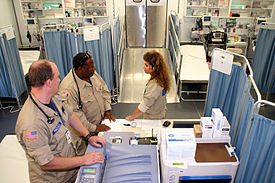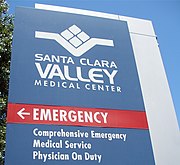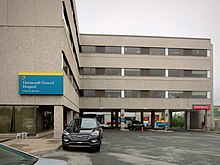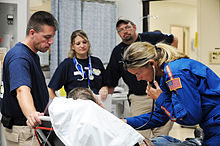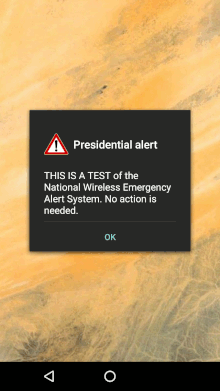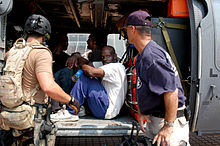The main patient area inside the Mobile Medical Unit operated in Belle Chasse, Louisiana
An emergency department (ED), also known as an accident & emergency department (A&E), emergency room (ER), emergency ward (EW) or casualty department, is a medical treatment facility specializing in emergency medicine, the acute care of patients who present without prior appointment; either by their own means or by that of an ambulance. The emergency department is usually found in a hospital or other primary care center.
Due to the unplanned nature of patient attendance, the department
must provide initial treatment for a broad spectrum of illnesses and
injuries, some of which may be life-threatening
and require immediate attention. In some countries, emergency
departments have become important entry points for those without other
means of access to medical care.
The emergency departments of most hospitals operate 24 hours a
day, although staffing levels may be varied in an attempt to reflect
patient volume.
History
Accident
services were already provided by workmen's compensation plans, railway
companies, and municipalities in Europe and the United States by the
late mid-nineteenth century, but the first specialized trauma care
center in the world was opened in 1911 in the United States at the
University of Louisville Hospital in Louisville, Kentucky,
and was developed by surgeon Arnold Griswold during the 1930s. Griswold
also equipped police and fire vehicles with medical supplies and
trained officers to give emergency care while en route to the hospital.
Today, a typical hospital has its emergency department in its own
section of the ground floor of the grounds, with its own dedicated
entrance. As patients can present at any time and with any complaint, a
key part of the operation of an emergency department is the
prioritization of cases based on clinical need. This process is called triage.
Triage is normally the first stage the patient passes through, and consists of a brief assessment, including a set of vital signs,
and the assignment of a "chief complaint" (e.g. chest pain, abdominal
pain, difficulty breathing, etc.). Most emergency departments have a
dedicated area for this process to take place, and may have staff
dedicated to performing nothing but a triage role. In most departments,
this role is fulfilled by a triage nurse,
although dependent on training levels in the country and area, other
health care professionals may perform the triage sorting, including paramedics or physicians.
Triage is typically conducted face-to-face when the patient presents,
or a form of triage may be conducted via radio with an ambulance crew;
in this method, the paramedics will call the hospital's triage center
with a short update about an incoming patient, who will then be triaged
to the appropriate level of care.
Most patients will be initially assessed at triage and then
passed to another area of the department, or another area of the
hospital, with their waiting time determined by their clinical need.
However, some patients may complete their treatment at the triage stage,
for instance if the condition is very minor and can be treated quickly,
if only advice is required, or if the emergency department is not a
suitable point of care for the patient. Conversely, patients with
evidently serious conditions, such as cardiac arrest, will bypass triage
altogether and move straight to the appropriate part of the department.
The resuscitation
area, commonly referred to as "Trauma" or "Resus", is a key area in
most departments. The most seriously ill or injured patients will be
dealt with in this area, as it contains the equipment and staff required
for dealing with immediately life-threatening illnesses and injuries.
Typical resuscitation staffing involves at least one attending
physician, and at least one and usually two nurses with trauma and Advanced Cardiac Life Support
training. These personnel may be assigned to the resuscitation area for
the entirety of the shift, or may be "on call" for resuscitation
coverage (i.e. if a critical case presents via walk-in triage or
ambulance, the team will be paged to the resuscitation area to deal with
the case immediately). Resuscitation cases may also be attended by residents, radiographers, ambulance personnel, respiratory therapists, hospital pharmacists
and/or students of any of these professions depending upon the skill
mix needed for any given case and whether or not the hospital provides
teaching services.
Patients who exhibit signs of being seriously ill but are not in
immediate danger of life or limb will be triaged to "acute care" or
"majors", where they will be seen by a physician and receive a more
thorough assessment and treatment. Examples of "majors" include chest
pain, difficulty breathing, abdominal pain and neurological complaints.
Advanced diagnostic testing may be conducted at this stage, including
laboratory testing of blood and/or urine, ultrasonography, CT or MRI
scanning. Medications appropriate to manage the patient's condition
will also be given. Depending on underlying causes of the patient's
chief complaint, he or she may be discharged home from this area or
admitted to the hospital for further treatment.
Patients whose condition is not immediately life-threatening will
be sent to an area suitable to deal with them, and these areas might
typically be termed as a prompt care or minors area. Such patients may still have been found to have significant problems, including fractures, dislocations, and lacerations requiring suturing.
Children can present particular challenges in treatment. Some departments have dedicated pediatrics areas, and some departments employ a play therapist
whose job is to put children at ease to reduce the anxiety caused by
visiting the emergency department, as well as provide distraction
therapy for simple procedures.
Many hospitals have a separate area for evaluation of psychiatric problems. These are often staffed by psychiatrists and mental health nurses and social workers. There is typically at least one room for people who are actively a risk to themselves or others (e.g. suicidal).
Fast decisions on life-and-death cases are critical in hospital
emergency departments. As a result, doctors face great pressures to
overtest and overtreat. The fear of missing something often leads to
extra blood tests and imaging scans for what may be harmless chest
pains, run-of-the-mill head bumps, and non-threatening stomach aches,
with a high cost on the health care system.
Nomenclature in English
Emergency department became commonly used when emergency medicine
was recognised as a medical specialty, and hospitals and medical
centres developed departments of emergency medicine to provide services.
Other common variations include 'emergency ward,' 'emergency centre' or
'emergency unit'.
'Accident and Emergency' or 'A&E' is still the accepted term in the United Kingdom, some Commonwealth countries,
and the Republic of Ireland, as are earlier terms such as 'Casualty' or
'casualty ward', which continue to be used informally. The same
applies to 'emergency room' or 'ER' in North America, originating when
emergency facilities were provided in a single room of the hospital by
the department of surgery.
Signage
Regardless
of naming convention, there is a widespread usage of directional
signage in white text on a red background across the world, which
indicates the location of the emergency department, or a hospital with
such facilities.
Signs on emergency departments may contain additional
information. In some American states there is close regulation of the
design and content of such signs. For example, California requires
wording such as "Comprehensive Emergency Medical Service" and "Physician
On Duty", to prevent persons in need of critical care from presenting to facilities that are not fully equipped and staffed.
In some countries, including the United States and Canada, a smaller facility that may provide assistance in medical emergencies is known as a clinic.
Larger communities often have walk-in clinics where people with medical
problems that would not be considered serious enough to warrant an
emergency department visit can be seen. These clinics often do not
operate on a 24-hour basis. Very large clinics may operate as
"free-standing emergency centres", which are open 24 hours and can
manage a very large number of conditions. However, if a patient presents
to a free-standing clinic with a condition requiring hospital
admission, he or she must be transferred to an actual hospital, as these
facilities do not have the capability to provide inpatient care.
- Examples of emergency department signage
United States
The Centers for Medicare and Medicaid Services
(CMS) classified emergency departments into two types: Type A, the
majority, which are open 24 hours a day, 7 days a week, 365 days a year;
and those who are not, Type B. Many US emergency departments are
exceedingly busy. A study found that in 2009, there were an estimated
128,885,040 ED encounters in US hospitals. Approximately one-fifth of ED
visits in 2010 were for patients under the age of 18 years. In 2009–2010, a total of 19.6 million emergency department visits in the United States were made by persons aged 65
and over. Most encounters (82.8 percent) resulted in treatment and release; 17.2 percent were admitted to inpatient care.
The 1986 Emergency Medical Treatment and Active Labor Act is an act of the United States Congress, that requires emergency departments, if the associated hospital receives payments from Medicare,
to provide appropriate medical examination and emergency treatment to
all individuals seeking treatment for a medical condition, regardless of
citizenship, legal status, or ability to pay. Like an unfunded mandate, there are no reimbursement provisions.
Rates of ED visits rose between 2006 and 2011 for almost every
patient characteristic and location. The total rate of ED visits
increased 4.5% in that time. However, the rate of visits for patients
under one year of age declined 8.3%.
A survey of New York area doctors in February 2007 found that
injuries and even deaths have been caused by excessive waits for
hospital beds by ED patients. A 2005 patient survey found an average ED wait time from 2.3 hours in Iowa to 5.0 hours in Arizona.
One inspection of Los Angeles area hospitals by Congressional
staff found the EDs operating at an average of 116% of capacity (meaning
there were more patients than available treatment spaces) with
insufficient beds to accommodate victims of a terrorist attack the size
of the 2004 Madrid train bombings.
Three of the five Level I trauma centres were on "diversion", meaning
ambulances with all but the most severely injured patients were being
directed elsewhere because the ED could not safely accommodate any more
patients.
This controversial practice was banned in Massachusetts (except for
major incidents, such as a fire in the ED), effective 1 January 2009; in
response, hospitals have devoted more staff to the ED at peak times and
moved some elective procedures to non-peak times.there were 1,800 EDs in the country.
In 2011, about 421 out of every 1,000 people in the United States
visited the emergency department; five times as many were discharged as
were admitted.
Rural areas are the highest rate of ED visits (502 per 1,000
population) and large metro counties had the lowest (319 visits per
1,000 population). By region, the Midwest had the highest rate of ED
visits (460 per 1,000 population) and Western States had the lowest (321
visits per 1,000 population).
Most Common Reasons for Discharged Emergency Department Visits in the United States, 2011
| Age (in years) | Reason for Visit | Visits |
|---|---|---|
| less than 1 | Fever of unknown origin | 270,000 |
| 1–17 | Superficial injury, contusion | 1.6 million |
| 18–44 | Sprains and Strains | 3.2 million |
| 45–64 | Nonspecific chest pain | 1.5 million |
| 65–84 | Nonspecific chest pain | 643,000 |
| 85+ | Superficial injury, contusion | 213,000 |
Freestanding
In
addition to the normal hospital based emergency departments a trend has
developed in some states (including Texas and Colorado) of emergency
departments not attached to hospitals. These new emergency departments
are referred to as free standing emergency departments. The rationale
for these operations is the ability to operate outside of hospital
policies that may lead to increased wait times and reduced patient
satisfaction.
These departments have attracted controversy due to consumer
confusion around their prices and insurance coverage. In 2017, the
largest operator, Adeptus Health, declared bankruptcy.
United Kingdom
The emergency department at The Royal Infirmary of Edinburgh
A&E sign common in the UK.
UK road sign to a hospital with A&E
All A&E departments throughout the United Kingdom are financed and managed publicly by the NHS of each constituent country (England, Scotland, Wales and Northern Ireland). As with most other NHS
services, emergency care is provided to all, both resident citizens and
those not ordinarily resident in the UK, free at the point of need and
regardless of any ability to pay.
In England departments are divided into three categories:
- Type 1 A&E department – major A&E, providing a consultant-led 24 hour service with full resuscitation facilities
- Type 2 A&E department – single specialty A&E service (e.g. ophthalmology, dentistry)
- Type 3 A&E department – other A&E/ minor injury unit/ walk-in centre, treating minor injuries and illnesses
Historically, waits for assessment in A&E were very long in some areas of the UK. In October 2002, the Department of Health introduced a four-hour target in emergency departments
that required departments in England to assess and treat patients
within four hours of arrival, with referral and assessment by other
departments if deemed necessary. It was expected that the patients would
have physically left the department within the four hours. Present
policy is that 95% of all patient cases do not "breach" this four-hour
wait. The busiest departments in the UK outside London include University Hospital of Wales in Cardiff, The North Wales Regional Hospital in Wrexham, the Royal Infirmary of Edinburgh and Queen Alexandra Hospital in Portsmouth.
In July 2014, the QualityWatch research programme published
in-depth analysis which tracked 41 million A&E attendances from 2010
to 2013.
This showed that the number of patients in a department at any one time
was closely linked to waiting times, and that crowding in A&E had
increased as a result of a growing and ageing population, compounded by
the freezing or reduction of A&E capacity. Between 2010/11 and
2012/13 crowding increased by 8%, despite a rise of just 3% in A&E
visits, and this trend looks set to continue. Other influential factors
identified by the report included temperature (with both hotter and
colder weather pushing up A&E visits), staffing and inpatient bed
numbers.
A&E services in the UK are often the focus of a great deal of
media and political interest, and data on A&E performance is
published weekly.
However, this is only one part of a complex urgent and emergency care
system. Reducing A&E waiting times therefore requires a
comprehensive, coordinated strategy across a range of related services.
Many A&E departments are crowded and confusing. Many of those
attending are understandably anxious, and some are mentally ill, and
especially at night are under the influence of alcohol or other
substances. Pearson Lloyd's redesign – 'A Better A&E' – is claimed
to have reduced aggression against hospital staff in the departments by
50 per cent. A system of environmental signage provides
location-specific information for patients. Screens provide live
information about how many cases are being handled and the current
status of the A&E department. Waiting times for patients to be seen at A&E have been rising.
Critical conditions handled
Cardiac arrest
Cardiac arrest
may occur in the ED/A&E or a patient may be transported by
ambulance to the emergency department already in this state. Treatment
is basic life support and advanced life support as taught in advanced life support and advanced cardiac life support courses.
Heart attack
Patients arriving to the emergency department with a myocardial
infarction (heart attack) are likely to be triaged to the resuscitation
area. They will receive oxygen and monitoring and have an early ECG; aspirin will be given if not contraindicated
or not already administered by the ambulance team; morphine or
diamorphine will be given for pain; sub lingual (under the tongue) or
buccal (between cheek and upper gum) glyceryl trinitrate (nitroglycerin) (GTN or NTG) will be given, unless contraindicated by the presence of other drugs.
An ECG
that reveals ST segment elevation suggests complete blockage of one of
the main coronary arteries. These patients require immediate reperfusion
(re-opening) of the occluded vessel. This can be achieved in two ways: thrombolysis (clot-busting medication) or percutaneous transluminal coronary angioplasty
(PTCA). Both of these are effective in reducing significantly the
mortality of myocardial infarction. Many centers are now moving to the
use of PTCA as it is somewhat more effective than thrombolysis if it can
be administered early. This may involve transfer to a nearby facility
with facilities for angioplasty.
Trauma
Major trauma, the term for patients with multiple injuries, often from a motor vehicle crash
or a major fall, is initially handled in the Emergency Department.
However, trauma is a separate (surgical) specialty from emergency
medicine (which is itself a medical specialty, and has certifications in
the United States from the American Board of Emergency Medicine).
Trauma is treated by a trauma team who have been trained using the principles taught in the internationally recognized Advanced Trauma Life Support (ATLS) course of the American College of Surgeons. Some other international training bodies have started to run similar courses based on the same principles.
The services that are provided in an emergency department can range from x-rays and the setting of broken bones to those of a full-scale trauma centre.
A patient's chance of survival is greatly improved if the patient
receives definitive treatment (i.e. surgery or reperfusion) within one
hour of an accident (such as a car accident) or onset of acute illness
(such as a heart attack). This critical time frame is commonly known as
the "golden hour".
Some emergency departments in smaller hospitals are located near a
helipad which is used by helicopters to transport a patient to a trauma
centre. This inter-hospital transfer is often done when a patient
requires advanced medical care unavailable at the local facility. In
such cases the emergency department can only stabilize the patient for transport.
Mental illness
Some
patients arrive at an emergency department for a complaint of mental
illness. In many jurisdictions (including many US states), patients who
appear to be mentally ill and to present a danger to themselves or
others may be brought against their will to an emergency department by
law enforcement officers for psychiatric examination. The emergency
department conducts medical clearance rather than treats acute
behavioral disorders. From the emergency department, patients with
significant mental illness may be transferred to a psychiatric unit (in
many cases involuntarily).
Asthma and COPD
Acute exacerbations of chronic respiratory diseases, mainly asthma and chronic obstructive pulmonary disease (COPD), are assessed as emergencies and treated with oxygen therapy, bronchodilators, steroids or theophylline, have an urgent chest X-ray and arterial blood gases and are referred for intensive care if necessary. Noninvasive ventilation in the ED has reduced the requirement for tracheal intubation in many cases of severe exacerbations of COPD.
Special facilities, training, and equipment
An
ED requires different equipment and different approaches than most
other hospital divisions. Patients frequently arrive with unstable
conditions, and so must be treated quickly. They may be unconscious, and
information such as their medical history, allergies, and blood type
may be unavailable. ED staff are trained to work quickly and effectively
even with minimal information.
ED staff must also interact efficiently with pre-hospital care providers such as EMTs, paramedics,
and others who are occasionally based in an ED. The pre-hospital
providers may use equipment unfamiliar to the average physician, but ED
physicians must be expert in using (and safely removing) specialized
equipment, since devices such as military anti-shock trousers ("MAST") and traction splints
require special procedures. Among other reasons, given that they must
be able to handle specialized equipment, physicians can now specialize
in emergency medicine, and EDs employ many such specialists.
ED staff have much in common with ambulance and fire crews, combat medics, search and rescue teams, and disaster response
teams. Often, joint training and practice drills are organized to
improve the coordination of this complex response system. Busy EDs
exchange a great deal of equipment with ambulance crews, and both must
provide for replacing, returning, or reimbursing for costly items.
Cardiac arrest and major trauma are relatively common in EDs, so defibrillators, automatic ventilation and CPR
machines, and bleeding control dressings are used heavily. Survival in
such cases is greatly enhanced by shortening the wait for key
interventions, and in recent years some of this specialized equipment
has spread to pre-hospital settings. The best-known example is
defibrillators, which spread first to ambulances, then in an automatic version
to police cars and fire apparatus, and most recently to public spaces
such as airports, office buildings, hotels, and even shopping malls.
Because time is such an essential factor in emergency treatment,
EDs typically have their own diagnostic equipment to avoid waiting for
equipment installed elsewhere in the hospital. Nearly all have
radiographic examination rooms staffed by dedicated Radiographer,
and many now have full radiology facilities including CT scanners and
ultrasonography equipment. Laboratory services may be handled on a
priority basis by the hospital lab, or the ED may have its own "STAT
Lab" for basic labs (blood counts, blood typing, toxicology screens,
etc.) that must be returned very rapidly.
Non-emergency use
Metrics
applicable to the ED can be grouped into three main categories, volume,
cycle time, and patient satisfaction. Volume metrics including arrivals
per hour, percentage of ED beds occupied and age of patients are
understood at a basic level at all hospitals as an indication for
staffing requirements. Cycle time metrics are the mainstays of the
evaluation and tracking of process efficiency and are less widespread
since an active effort is needed to collect and analyze this data.
Patient satisfaction metrics, already commonly collected by nursing
groups, physician groups and hospitals, are useful in demonstrating the
impact of changes in patient perception of care over time. Since patient
satisfaction metrics are derivative and subjective, they are less
useful in primary process improvement. Health information exchanges can
reduce nonurgent ED visits by supplying current data about admissions, discharges, and transfers to health plans and accountable care organizations, allowing them to shift ED use to primary care settings.
In all Primary Care Trusts there are out of hours medical consultations provided by general practitioners or nurse practitioners.
In the United States, high costs are incurred by non-emergency
use of the emergency room. The National Hospital Ambulatory Medical Care
Survey looked ath the ten most common symptoms for which giving rise to
emergency room visits (cough, sore throat, back pain, fever, headache,
abdominal pain, chest pain, other pain, shortness of breath, vomiting)
and made suggestions as to which would be the most cost-effective choice
among virtual care, retail clinic, urgent care or emergency room. Notably, certain complaints may also be addressed by a telephone call to a person's primary care provider.
In the United States, and many other countries, hospitals are
beginning to create areas in their emergency rooms for people with minor
injuries. These are commonly referred as Fast Track or Minor Care
units. These units are for people with non-life-threatening injuries.
The use of these units within a department have been shown to
significantly improve the flow of patients through a department and to
reduce waiting times. Urgent care
clinics are another alternative, where patients can go to receive
immediate care for non-life-threatening conditions. To reduce the strain
on limited ED resources, American Medical Response created a checklist that allows EMTs to identify intoxicated individuals who can be safely sent to detoxification facilities instead.
Overcrowding
Emergency
department overcrowding is when function of a department is hindered by
an inability to treat all patients in an adequate manner. This is a
common occurrence in emergency departments worldwide. Overcrowding causes inadequate patient care which leads to poorer patient outcomes.
To address this problem, escalation policies are used by emergency
departments when responding to an increase in demand (e.g., a sudden
inflow of patients) or a reduction in capacity (e.g., a lack of beds to
admit patients). The policies aim to maintain the ability to deliver
patient care, without compromising safety, by modifying ‘normal’
processes.
Emergency department waiting times
Emergency department (ED) waiting times have a serious impact on patient mortality, morbidity with readmission
in less than 30 days, length of stay, and patient satisfaction. A
review of the literature bears out the logical premise that since the
outcome of treatment for all diseases and injuries is time-sensitive,
the sooner treatment is rendered, the better the outcome.
Various studies reported significant associations between waiting times
and higher mortality and morbidity among those who survived. It is clear from the literature that untimely hospital deaths and morbidity can be reduced by reductions in ED waiting times.
Exit block
While
a significant proportion of people attending emergency departments are
discharged home after treatment, many require admission for ongoing
observation or treatment, or to ensure adequate social care before
discharge is possible. If people requiring admission are not able to be
moved to inpatient beds swiftly, "exit block" or "access block" occurs.
This often leads to crowding and impairs flow to the point that it can
lead to delays in appropriate treatment for newly presenting cases
("arrival access block"). This phenomenon is more common in densely populated areas, and affects pediatric departments less than adults ones.
Exit block can lead to delays in care both in the people awaiting
inpatient beds ("boarding") and those who newly present to an exit
blocked department. Various solutions have been proposed, such as
changes in staffing or increasing inpatient capacity.
Frequent presenters
Frequent
presenters are persons who will present themselves at a hospital
multiple times, usually those with complex medical requirements or with
psychological issues complicating medical management.
These persons contribute to overcrowding and typically require more
hospital resources although they do not account for a significant number
of visits.
To help prevent inappropriate emergency department use and return
visits, some hospitals offer care coordination and support services such
as at-home and in-shelter transitional primary care for frequent
presenters and short-term housing for homeless patients recovering after
discharge.
In the military
Emergency
departments in the military benefit from the added support of enlisted
personnel who are capable of performing a wide variety of tasks they
have been trained for through specialized military schooling. For
example, in United States Military Hospitals, Air Force Aerospace
Medical Technicians and Navy Hospital Corpsmen perform tasks that fall
under the scope of practice of both doctors (i.e. sutures, staples and
incision and drainages) and nurses (i.e. medication administration,
foley catheter insertion, and obtaining intravenous access) and also
perform splinting of injured extremities, nasogastric tube insertion,
intubation, wound cauterizing, eye irrigation, and much more. Often,
some civilian education and/or certification will be required such as an
EMT certification, in case of the need to provide care outside the base
where the member is stationed. The presence of highly trained enlisted
personnel in an Emergency Departments drastically reduces the workload
on nurses and doctors.
Violence against health care workers
According to a survey at an urban inner-city tertiary care centre in Vancouver,
57% of health care workers were physically assaulted in 1996. 73% were
afraid of patients as a result of violence, almost half, 49%, hid their
identities from patients, 74% had reduced job satisfaction. Over
one-quarter of the respondents took days off because of violence. Of
respondents no longer working in the emergency department, 67% reported
that they had left the job at least partly owing to violence.
Twenty-four-hour security and a workshop on violence prevention
strategies were felt to be the most useful potential interventions.
Physical exercise, sleep and the company of family and friends were the
most frequent coping strategies cited by those surveyed.
Medication errors
Emergency Department of Dartmouth General Hospital
Medication errors are issues that lead to incorrect medication distribution or potential for patient harm.
As of 2014, around 3% of all hospital-related adverse effects were due
to medication errors in the emergency department (ED); between 4% and
14% of medications given to patients in the ED were incorrect and
children were particularly at risk.
Errors can arise if the doctor prescribes the wrong medication,
if the prescription intended by the doctor is not the one actually
communicated to the pharmacy due to an illegibly-written prescription
or misheard verbal order, if the pharmacy dispenses the wrong
medication, or if the medication is then given to the wrong person.
The ED is a riskier environment than other areas of the hospital
due to medical practitioners not knowing the patient as well as they
know longer term hospital patients, due to time pressure caused by
overcrowding, and due to the emergency-driven nature of the medicine
that is practiced there.
